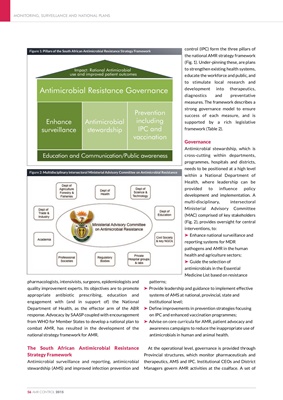
pharmacologists, intensivists, surgeons, epidemiologists and
quality improvement experts. Its objectives are to promote
appropriate antibiotic prescribing, education and
engagement with (and in support of) the National
Department of Health, as the effector arm of the ABR
response. Advocacy by SAASP coupled with encouragement
from WHO for Member States to develop a national plan to
combat AMR, has resulted in the development of the
national strategy framework for AMR.
The South African Antimicrobial Resistance
Strategy Framework
Antimicrobial surveillance and reporting, antimicrobial
stewardship (AMS) and improved infection prevention and
control (IPC) form the three pillars of
the national AMR strategy framework
(Fig. 1). Under-pinning these, are plans
to strengthen existing health systems,
educate the workforce and public, and
to stimulate local research and
development into therapeutics,
diagnostics and preventative
measures. The framework describes a
strong governance model to ensure
success of each measure, and is
supported by a rich legislative
framework (Table 2).
Governance
Antimicrobial stewardship, which is
cross-cutting within departments,
programmes, hospitals and districts,
needs to be positioned at a high level
within a National Department of
Health, where leadership can be
provided to influence policy
development and implementation. A
multi-disciplinary, intersectoral
Ministerial Advisory Committee
(MAC) comprised of key stakeholders
(Fig. 2), provides oversight for central
interventions, to:
‰ Enhance national surveillance and
reporting systems for MDR
pathogens and AMR in the human
health and agriculture sectors;
‰ Guide the selection of
antimicrobials in the Essential
Medicine List based on resistance
patterns;
‰ Provide leadership and guidance to implement effective
systems of AMS at national, provincial, state and
institutional level;
‰ Define improvements in prevention strategies focusing
on IPC and enhanced vaccination programmes;
‰ Advise on core curricula for AMR, patient advocacy and
awareness campaigns to reduce the inappropriate use of
antimicrobials in human and animal health.
At the operational level, governance is provided through
Provincial structures, which monitor pharmaceuticals and
therapeutics, AMS and IPC. Institutional CEOs and District
Managers govern AMR activities at the coalface. A set of
MONITORING, SURVEILLANCE AND NATIONAL PLANS
56 AMR CONTROL 2015
Antimicrobial Resistance Governance
Enhance
surveillance
Antimicrobial
stewardship
Prevention
including
IPC and
vaccination
Impact: Rational Antimicrobial
use and improved patient outcomes
Education and Communication/Public awareness
Figure 1: Pillars of the South African Antimicrobial Resistance Strategy Framework
Figure 2: Multidisciplinary intersectoral Ministerial Advisory Committee on Antimicrobial Resistance